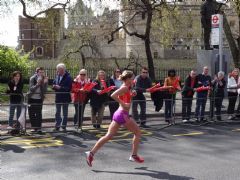Following the International Scientific Tendinopathy Symposium held in Vancouver last year (2012), the research & clinical professionals that contributed to the round table discussion (myself included) on the current assessment, management, treatment, rehabilitation & prevention of tendinopathy have been working to write a consensus paper on the topic.
Coordinated by Alex Scott, Head of Experimental Medicine at University of British Columbia, Vancouver, a draft paper was authored & subsequently submitted to the British Journal of Sports Medicine last month. After a few amendments, I am delighted to report that the journal's editorial panel have accepted the paper & it will be published later this year. I will of course let you know which edition it is in.
A couple of interesting papers related to Achilles tendinopathy that have been published this year look at the influence of the contraceptive pill on the in vivo passive stiffness of the calf muscle-tendon unit & the rate of turnover in the Achilles tendon itself.
Morse et al (2013) conducted a study on a population of 24 females, with the experimental group of 12 subjects having been taking the monophasic oral contraceptive pill (MOCP) for a sustained period (minimum of 12 months) & the control group of 12 subjects having never taken it. The aim was to determine the effect of sustained MOCP use on the in vivo passive stiffness of the gastrocnemius medialis muscle tendon unit.
Ultrasonography was used to measure the distal displacement of the myotendinous junction of the gastrocnemius medialis at 2 Nm increments to 20 Nm during passive dorsiflexion & at the end of the range of movement. In addition, the myotendinous junction displacement was measured at passive torques equivalent to 5, 10 & 15% of plantarflexion maximal voluntary contraction torque & relative to the muscle length.
The authors reported a significantly greater myotendinous junction displacement at all passive torques (P <0.01) in the experimental group, reaching 40% more at 20 Nm. The displacements remained significantly different when the maximum voluntary contraction & muscle length were accounted for. In addition, the passive muscle stiffness from 0-20 Nm was 31% less in MOCP users compared to the control group (P<0.01).
This will have clinical relevance when considering the magnitude of kinetic energy storage/release during running & the demands imparted on the Achilles tendon in this specific population. Further studies looking at an athletic population, other muscle groups, different contraceptive pills & with a greater study population would be of great interest.
The second paper by Heinemeier et al (2013), published in the FASEB Journal, aimed to establish the rate of Achilles tendon regeneration. Between 1955 & 1963, nuclear testing caused a marked global spike in the atmospheric levels of carbon-14. Whilst many cells regenerate throughout life, body parts such as teeth that don't regenerate once adulthood is reached, retain detectable levels of the isotope in individuals that were alive at that time.
The authors measured samples of Achilles tendon tissue from 28 subjects that were born between 1945 & 1983, in addition to muscle samples from the same population. Comparing expected C-14 levels, based on a running average of atmospheric levels during the first 17 years of the subjects' lives, to those observed when the samples were harvested in 2000, the results demonstrated that C-14 levels almost perfectly matched.
These results indicate that the tendons haven't changed since adulthood, whilst the muscle samples that were tested illustrated a complete turnover of the tissue, with no traces of C-14 being detected.
Clinically this highlights the importance of addressing tendinopathy when the symptoms occur initially & implementing strategies to prevent further pathological episodes, which may lead to degenerative changes.

